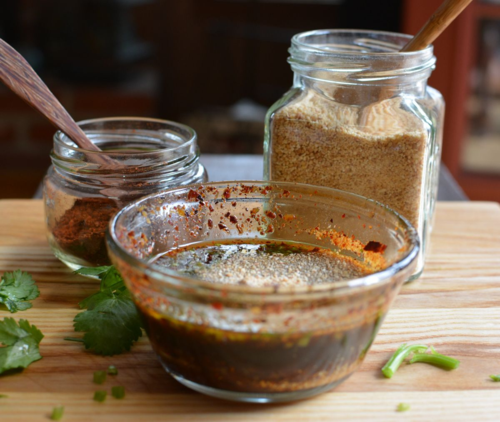The first time I had this Thai sauce was a couple of years ago at Kris Yenbamroong’s Night + Market in Los Angeles. I couldn’t decipher exactly what he and his Thai cooks did to pull the inky, spicy, savory, tangy, nutty, pungent sauce together. It was full of textures with flecks of red and nubby bits. We were smitten.
Like a lot of the food on the menu at Night + Market, the dipping sauce broadened our understanding of what Thai food is. The jaew sauce was paired with grilled pork collar – I know it sounds weird but believe me, it was wonderful, uncommon Thai cooking in America. Gutsy sauce with fatty meat. Few things are better.
When I spotted the jaew as an accompaniment to Thai-style pork ribs in Andy Ricker’s Pok Pok cookbook, I had to make it. As I mentioned earlier, I nearly took some shortcuts but then decided to follow his directions. Major payoff. This is one of the most interesting Asian dipping sauces around and I urge you to try it out, explore different renditions.
Ricker’s recipe combines three (3!) sources of umami:

Thai seasoning sauce is basically the Thai version of Maggi Seasoning, which you know I’m a fan of. Golden Mountain is the leading Thai brand. Having the three sauces in there – soy, fish, and seasoning sauces – lends jaew its alluring savory depth.
Then there’s the herbaceousness of lemongrass, tartness of lime juice, sweetness of palm sugar, and smoky heat of toasted chile. For texture, Ricker adds ground toasted rice and chopped cilantro right before serving to allow their flavors to pop.
It was just sensational when we had it with the Thai-style ribs (which I’ll write about next), but got me wondering about other renditions of jaew. I looked through a dozen or so Thai cookbooks on my shelves, some published in Thailand and others in America. Nancie McDermott included a roasted tomato jaew in her 1992 book, Real Thai. It reminded me of a thick, sambal type of relish. Nancie wrote that the sauce went with northeastern-style sun-dried beef (neua kem).
Leela Punyaratabandhu at She Simmers posted a recipe for jaew that included galangal and shallot. I like the raw pungency of those elements, and the simplicity of her overall approach, which you’ll likely find in her upcoming book on Thai home cooking.
What was enlightening was Leela’s mention of how grilled Thai-style chicken (gai yang) is often sold with both the jaew and the sweet chile sauce. I vaguely remember that when I was in Thailand in the early 1990s. Why the heck don’t we get that in the U.S.? It’s likely easier for Thai restaurants to pour the sweet chile sauce from a bottle than to make jaew from scratch.
Well, since you can’t buy this stuff, why not make it yourself? It’s a cinch with a few Thai pantry items in your back pocket. The cool thing about Ricker’s recipe is that the foundational sauce can keep for 2 days in the fridge. You just finish it and serve. It’s practically like pouring it out of the bottle, but you made it yourself. Ricker called for coarsely chopping cilantro stems and leaves but I went for finely chopped stems that it played well with the other ingredients.
Note: I use a reamer to squeeze my citrus because I love the pulp. If you use a press, back off the citrus a bit.
P.S. After reading this post, Ricker informed me via Facebook that jaew is a generic term for a broad range of sauces. At Pok Pok in Portland, they make one for grilled chicken that's heavy on tamarind. He also favors jaew bong with buffalo skin.
RECIPE
Jaew
Yield: ½ cup to serve 4
Ingredients
- 2 large stalks lemongrass
- 2 tablespoons fish sauce
- 1 ½ tablespoons light (regular) soy sauce
- ¾ teaspoon Thai seasoning sauce or Maggi Seasoning Sauce
- 3 tablespoons fresh lime juice
- 1 ½ teaspoons fresh Meyer lemon juice or unseasoned rice vinegar (to mellow the regular lime juice)
- 1 ½ tablespoons Palm Sugar Simple Syrup
- 2 to 3 teaspoons Toasted Chile Powder
- 1 tablespoon Toasted Sticky Rice Powder
- 1 tablespoon finely chopped cilantro stems
Method
- Trim the lemongrass down to the tender center. Cut crosswise into sections, then halve lengthwise. Thinly slice. Pound with a mortar and pestle to a coarse paste, about 1 minute. Transfer to a bowl. Add the fish sauce, soy sauce, seasoning sauce, lime and lemon juices (or vinegar), sugar syrup and chile powder.
- Stir to combine, then set aside for 1 hour to bloom. Or cover and refrigerate for up to 2 days, returning to room temperature before finishing. To finish, add the sticky rice powder and cilantro. Stir then serve with the grilled meat of your choice!
Adapted from Pok Pok by Andy Ricker and J J Goode
Related recipes that you could serve jaew with:



















Christine says
That looks GOOD. Do you think it's similar to the Laotion jaew bong?
Andrea Nguyen says
Christine, I don't know. Andy just wrote that there's a Thai jaew bong with buffalo skin. Does the Lao version contain that? This is all so new to me. Do you happen to have a recipe to point me to? Seriously.
Andrea Nguyen says
Christine, I just asked for you and Andy Ricker said that jaew bong is Lao. So there you have it! Culinary ideas are borderless.
Niki says
Andrea,
In the Lao jaew bong the flavored of galangal and roasted peppers is prevalent. Personally, I wouldn't add other soy sauces besides fish sauce, but that is your version. You can cut out the MSG of course. When I read your post about the roasted peppers and burnt rice, I thought about eating it with sour things like green mangos, goose berries and green almonds or a laarb. Laotians/Thais who eat with jaew bong like it with the meat and sticky rice. Darly has a pretty good recipe for authentic jaew bonghttp://saodarly.com/how-to-make-jeow-bong/.
Christine says
Thanks! I remember eating it as a child and just learned the name of it a couple months ago. I'm glad you posted this recipe as I've wanted to try it again. I remember dipping sticky rice into it, so simple yet so satisfying!
Hanuman says
Jaew Bong in Laos and North East Thailand are different things. In laos it will be similar to the Thai NapPrik Ka or Galangal chili relish, made out of dry galangal powder, fried garlic and pladek (fermented fish) with the addition of fire roasted and than boiled buffalo skin strips.
In Thailand it is refereed to a relish made from chopped fermented fish with aromatics.
Padaek says
This sauce looks and sounds delicious - love your combo of ingredients; use of khao khua, lemon grass and coriander - I can just imagine how flavoursome all the ingredients would dance in my mouth! 🙂 This sauce would go so well with grilled meats, ox tongue and rice too. Great recipe! So saab. 🙂
Andrea Nguyen says
Thanks for the clarification. Excellent.
Andrea Nguyen says
Niki -- I didn't come up with this version but rather it's from Andy Ricker's Pok Pok in Portland. The blending of seasoning sauces creates an umami party on your palate. Take it as a restaurant/chef-fy thing. The sauce is remarkably good. There are obviously other jaew to try too! Very exciting.
Thanks so much for the info on Lao jaew bong the link to Darly's site! Awesome.
Andrea Nguyen says
You are so right! I had on my rice last night and it was splendid. Ox/beef tongue would benefit from the jaew too.
What is "saab"? My Thai is a little rusty... 😉
Nancie McDermott says
Saab is Lao for 'delicious!' 'tasty'; like 'aroy' in Thai.
If you love it lots, 'saab e-lee' or 'aroy mahk'...
Andrea Nguyen says
Ah, got it. Now I've got a little Lao and Thai to show off. So the brand of Thai coconut milk -- Aroy-D stands for "delicious something"?
Padaek says
^^ As above - thanks Nancie! 🙂 I believe d means good in Lao and Thai and is also a confirmation - aroy d = is delicious. Whats Vietnamese for delicious in Andrea? 😀
Padaek says
^ Oops - please omit in.. 🙂
Andrea Nguyen says
Viet people would say "ngon" for delicious, good tasting. If you really like something, you'd say "ngon qua." Thank you!
Rex Hays says
Andrea, where do you find Thai ingredients in the Bay Area? I've been looking for the Thai Seasoning Sauce and I struck out. Can you help me? I'm frustrated. I found Chinese, German and Vietnamese, but no Thai. Do you think it makes that much difference?
Thank you!
Rex